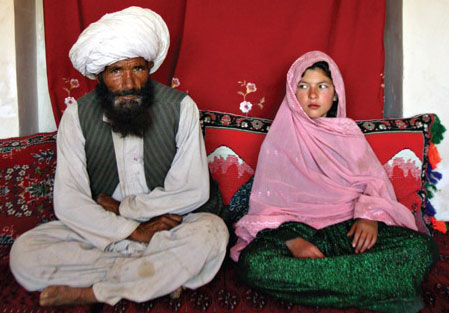U.S. State Dept Trafficking in Persons Report 2009
— See also “Sudan: Women and Other Slaves Freed”
Gender Imbalance in Human Trafficking
— Introduction, page 36 (hard copy), page 38 (electronic)
“The root causes of migration and trafficking greatly overlap. The lack of rights afforded to women serves as the primary causative factor at the root of both women’s migrations and trafficking in women…By failure to protect and promote women’s civil, political, economic and social rights, governments create situations in which trafficking flourishes.”
— Radhika Coomaraswamy, UN Special Rapporteur on Violence Against Women
———————————————————————
“According to the ILO, the majority of people trafficked for sexual exploitation or subjected to forced labor are female.”
“According to researchers, both the supply and demand sides of the trade in human beings are fed by ‘gendered’ vulnerabilities to trafficking. These vulnerabilities are the result of political, economic, and development processes that may leave some women socially and economically dependent on men. If that support from men becomes limited or withdrawn, women become dangerously susceptible to abuse. They often have no individual protection or recognition under the law, inadequate access to healthcare and education, poor employment prospects, little opportunity to own property, or high levels of social isolation. All this makes some women easy targets for harassment, violence, and human trafficking.”
“Research links the disproportionate demand for female trafficking victims to the growth of certain ‘feminized’ economic sectors (commercial sex, the ‘bride trade,’ domestic service) and other sectors characterized by low wages, hazardous conditions, and an absence of collective bargaining mechanisms. Exploitative employers prefer to use trafficked women — traditionally seen as submissive, cheap, and pliable — for simple and repetitive tasks in agriculture, food processing, labor-intensive manufacturing, and domestic servitude.”
“In countries where women’s economic status has improved, significantly fewer local women participate in commercial sex. Traffickers bring in more female victims to address the demand and also take advantage of women who migrate voluntarily to work in any industry. As commercial sex is illegal in most countries, traffickers use the resulting illegal status of migrant women that have been trafficked into commercial sex to threaten or coerce them against leaving. Gendered vulnerabilities fostered by social and institutional weaknesses in some societies — discriminatory laws and practices that tie a woman’s legal recognition, property rights, and economic opportunities to someone else — make women more likely than men to become trafficking victims. A woman who exists only through a male guardian who controls her income, identification, citizenship, and physical well-being is more susceptible to becoming a trafficking victim.”

Image from State Dept 2009 Human Trafficking Report, section "Gender Imbalance in Human Trafficking"
Some Tier 3, 2 Watch, and 2 nations include (see Introduction, page 50 (hard copy), 52 (electronic copy) for complete list)
Tier 3 Nations include:
— Saudi Arabia
— Iran
— Syria
— Sudan
— Kuwait
— Malaysia
— Mauritania
— Communist North Korea
Tier 2 Watch List Nations include:
— Pakistan
— Iraq
— Lebanon
— Algeria
— Yemen
— United Arab Emirates
— Egypt
— India
— Russia
— Communist China
Tier 2 Nations include:
— Afghanistan
— Jordan
— Kosovo
— Turkey
— Communist Vietnam
————————————–
“The ninth annual Trafficking in Persons Report sheds light on the faces of modern-day slavery and on new facets of this global problem. The human trafficking phenomenon affects virtually every country, including the United States. In acknowledging America’s own struggle with modern-day slavery and slavery-related practices, we offer partnership. We call on every government to join us in working to build consensus and leverage resources to eliminate all forms of human trafficking.”
–Secretary Clinton, June 16, 2009
The Report
The report is available in PDF format as a single file [PDF: 22 MB ]. Due to its large size, the PDF has been separated into sections for easier download: Introduction; Country Narratives: A-C, D-K, L-P, Q-Z/Special Cases; Relevant International Conventions. To view the PDF file, you will need to download, at no cost, the Adobe Acrobat Reader.
]. Due to its large size, the PDF has been separated into sections for easier download: Introduction; Country Narratives: A-C, D-K, L-P, Q-Z/Special Cases; Relevant International Conventions. To view the PDF file, you will need to download, at no cost, the Adobe Acrobat Reader.
–PDF Version: Trafficking in Persons Report, June 2009
–Introduction (PDF) [5071 Kb]
–Country Narratives: A-C (PDF) [4074 Kb]
–Country Narratives: D-K (PDF) [3889 Kb]
–Country Narratives: L-P (PDF) [4036 Kb]
–Country Narratives: Q-Z and Special Cases (PDF) [3868 Kb]
–Relevant International Conventions (PDF)
———————————-
Additional News Reports on Human Trafficking Watch List
— Expanded Human Trafficking Watchlist Puts Dozens of Countries on Notice
— Iran not doing enough to combat human trafficking, says US
— US adds Pakistan to human trafficking watchlist
